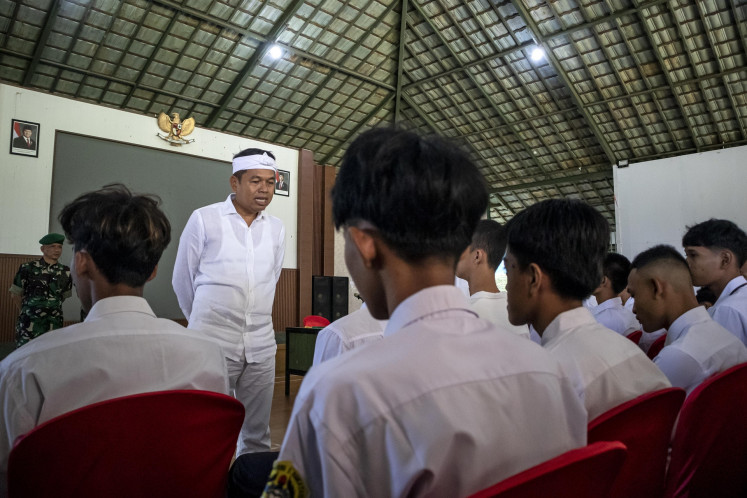Thin, light notebook packs lots of power
www
Change text size
Gift Premium Articles
to Anyone

www.samsung.com
Samsung is a late-comer in the notebook business compared to Acer, Apple, Dell, Fujitsu, HP and Sony.
However the Korean company has been selling PCs in the US and has several things going for it in the PC industry.
First it is the world’s No. 1 maker of LCD and LED panels. It is also the world’s No. 1 batteries maker. It has been making award-winning hard disks and optical disk drive (ODD) and memory chips.
All in all, it manufactures up to 75 percent of all the components that go into a notebook. To top it all, it has its own manufacturing facility to build the electronics that it sells.
In the past year it has sold its netbooks and notebooks here, best known for their stylishness.
But how does it fare in the high-end notebook segment? Its latest model has a lot of potential to catapult it into the league of notebook makers to reckon with.
I am referring to Samsung Series 9, a paper-thin notebook unveiled to the media here recently. Because of its lightness and thinness, it easily competes against the MacBook Air (MBA) and Lenovo ThinkPad T420s.
“Currently, it is the thinnest and the lightest notebook in the world,” claimed Felix Ignatius Tanumihardja, the spokesperson for Samsung Electronics Indonesia, during the product launch.
Series 9 weighs 1.31 kilograms and is 16.6 millimeters thick — at its thickest point. With this kind of lightness and slimness, one cannot help but compare it with the MBA. However, despite the similarities between the two notebooks, keep in mind that, unlike the MBA, the Series 9 is a Windows machine.
The Series 9’s body is made of Duralumin, a material used in aircraft fuselage because of its strength and lightweight. The notebook comes in matte black.
It is a gorgeous-looking notebook especially when looking at it from the side. From either side, the curvy arches resemble an Italian-made supercar.
The 13.3-inch, 1366x768 SuperBright Plus screen has a brightness level of up to 400nit. “Nit” is a measure for the intensity of visible light emanating from an LCD screen. Other notebooks usually deliver only around 250 to 300 nits. While the extra brightness is useful for working outdoors, it will hurt our eyes if we work in a room with little ambient light.
But, not to worry, the Series 9 has a responsive sensor that will detect whether we are working under
the direct sunlight or inside our cubicle — and will reduce the nits accordingly. Not only that, the
auto light sensor will also automatically turn on the keyboard backlighting.
Like almost all full power notebooks of today, the Series 9 is propelled by an Intel Second Generation Core processor, a.k.a Sandy Bridge. The displayed unit during the launch event ran on a Core i5 processor. It also comes with 4GB of RAM and a 128GB Solid State Drive (SSD).
Samsung has also implemented its Fast Start technology to expedite the boot up and shutdown processes. It only requires 3 seconds to wake up from its sleep mode.
The battery needs some scrutiny as Samsung has implanted a new feature in it. I was told the recharger would automatically stop recharging when the battery was already around 80 percent full.
Samsung has found this method extends the battery lifespan to twice that of a battery always recharged to almost 100 percent of its capacity. Felix said the number of cycles (the times the battery is charged and fully discharged) throughout its life was expected to be 1,000, while most other batteries only have 500 cycles.
The keyboard is comfortable to use. In his presentation, Felix told the audience that all the keys went through a test to ensure they would not break or become sticky.
I was a bit concerned about the lid and hinges. They flex quite a bit. If you are familiar with the
solidness of Lenovo ThinkPad T Series, you will understand why I was worried.
However, Felix assured me the LCD panel would not crack. Felix told us the notebook underwent 25,000 open-and-shuts to test its durability.
What should we watch out for? Like the battery inside the MBA, the one in the Series 9 is not user replaceable.
We need to be more careful in maintaining the battery to obtain its maximum longevity. Secondly, the lid can only be opened around 120 degrees, while a ThinkPad can lie completely flat from the upper edge of the screen to the lower edge of the machine.
There is an airflow grill at the bottom of the notebook, so it is not advisable to take the Series 9 to your bed to finish your work — unless you can make sure the flow of the air is not obstructed by your bed cover or blanket.
After a while, people will notice this is a premium notebook targeted mainly at successful business owners or budding executives.
At US$1,659, though, it is definitely not for me. But, if you want a powerful Windows notebook that is extremely light and thin today, you should definitely consider this one.









